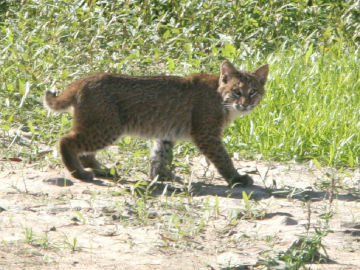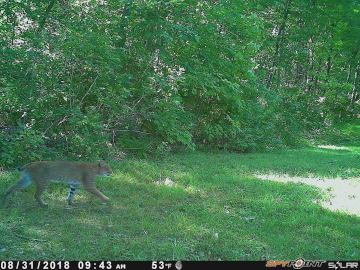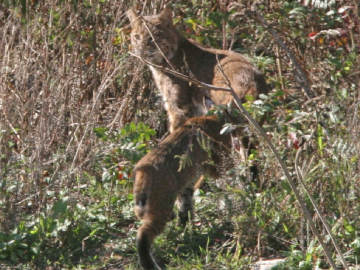Nature Notes

PHOTO COURTESY OF GARRY KESSLER
A juvenal bobcat
August 21, 2024
NATURE NOTES
By Annie Reid
Westborough Community Land Trust
Adaptable but shy bobcats are our neighbors
Rumors have suggested for years that bobcats live in local woods in places such as Westborough. Today there’s little doubt that bobcats (Lynx rufus) inhabit, or at least visit, woods in Westborough and other towns in the region.
Why think so? Well, for example, in recent years bobcat sightings have been reported to Westborough’s animal control officer (6 sightings in 2023, 1 in 2022). And at least one homeowner’s trail camera photographed a bobcat (August 2018). Another resident captured a bobcat on video (2022, link below).
You might imagine bobcats as large, but in reality, a bobcat is about twice the size of a housecat. Adult bobcats weigh 15-35 pounds and are about 2-4 feet (28-47 inches) long. Males are about one-third larger than females.

PHOTO COURTESY OF ANN STETSON
A bobcat recorded by a homeowner’s trail camera in Westborough
Bobcats are named for their short tails (6-12 inches). Their bobbing gait while running may also have contributed to their name. A ruff – long hair on their cheeks – frames their face. Their ears have short black tufts. A white spot on the back of bobcat ears helps young bobcats follow in a line behind their mother, eyes on the white dots ahead. Bobcat coats are soft and dense, changing with the seasons from reddish brown in summer to grayish brown in winter. Blurry spots or bars on their coats add camouflage. The tip of their tail is black, but only on top. Their eyes are yellowish brown.
Why don’t most of us see bobcats? For one, they’re active mainly at dawn, dusk, or night, when their prey is active. We’re not usually out in the woods then. Like housecats, bobcats have eyes that see especially well in the dark. They see six times as well as humans in dim light, thanks to more rods and cones in their eyes and a layer of tissue at the back of their eyes that reflects light. This special tissue also creates the glowing “eyeshine” that bobcats (and many other animals) have in the dark.
There’s another reason we don’t see bobcats. They are, by nature, shy and secretive. They don’t want to be seen, either by potential prey, such as rabbits, squirrels, and mice, or by potential enemies, such as coyotes and humans. You’re unlikely to meet a bobcat on local trails. If a bobcat hears or sees you coming, it will make itself scarce. (Watch a bobcat running away in this 2022 video https://westboroughlandtrust.org/nn/videos/Bobcat.mp4 courtesy of Willy Dupree.) Their hearing, like their vision, is very good. They rely on hearing and vision far more than on their sense of smell.
You might spot a bobcat’s track in mud or sand. Their footprints are about 2 inches wide – twice as large as a housecat’s (1-1/8 inch) – and round, or a bit wider than long. The prints show four toes and a heel pad, but NO claws. Bobcats have retractable claws, like housecats, so claws don’t appear in their footprints. (Dog, fox, and coyote tracks can show claws.) Bobcats use their claws in hunting, self-defense, and climbing or escaping up trees. A male bobcat might advertise its presence by tearing up the bark on a small tree (as well as by scent-marking).
Bobcats are solitary hunters with great patience and persistence. If you’ve had a pet cat, the bobcat’s hunting style might seem familiar. Bobcats typically stalk their prey, quietly and slowly creeping up on it, step by step, until it’s within reach of a long, quick pounce (7-10 feet). Bobcats also sit – or perch – and wait quietly for hours near a prey’s trail or feeding area, until the unsuspecting prey comes to them. Bobcats make quick kills by biting with their four long canine teeth.

PHOTO COURTESY OF GARRY KESSLER
A female bobcat with juvenile, both well camouflaged in a brushy area
As carnivores, bobcats eat an all-meat diet, typically without fruit or plant matter. As medium-sized predators, they are important in controlling wild rodent populations. Besides their main prey of squirrels, rabbits, and mice, bobcats hunt voles, muskrats, minks, opossums, skunks, foxes, porcupines, wild turkeys, chickens, chipmunks, beavers, bats, snakes, ducks, and even fish. Bobcats can swim well but tend to avoid water. They’ll dine on carrion (dead meat) if it’s not too decomposed. They’ll also catch frogs and grasshoppers. If their kill is more than they can eat right away, they cover or “cache” it with dirt, leaves, or snow and return later.
Do bobcats kill deer? Only rarely. Bobcats look for fawns in the spring, although fawns are more often killed by coyotes or black bears. If a bobcat takes an adult deer, it’s typically a wounded, ill, or old deer.
Male and female bobcats inhabit separate but often overlapping ranges. At this time of year, in late summer, female bobcats lead their partly grown young around, showing them where and how to hunt food. For shelter, they use rock ledges and outcrops, brush or log piles, or hollow trees. In fall, young males usually leave the family group to find a territory of their own. Young females may stay with their mother until spring.
Bobcats in Massachusetts breed in late winter, February-March. Male and female spend just a day or two together, with a lot of chasing, yowling, and “screaming.” Then the male departs in search of additional females. In April-May, about 62 days later, the female gives birth to kittens (“bobkittens”), typically two, and raises and trains them alone. Kittens can be in danger from coyotes, great horned owls, and male bobcats.
Bobcats are successful today because of their adaptability in taking advantage of a variety of habitats and a variety of prey. They are native to New England and much of the continental U.S., southern Canada, and much of Mexico. They were here when European colonists arrived and started killing off predators. Bobcats became less common as they were hunted and as agriculture transformed the wooded landscape into farm fields and pastures lacking brushy cover. Since the 1950s, bobcats have lived in the western two-thirds of Massachusetts. They are now moving eastward and adapting to suburban areas. There’s a hunting season for bobcats in western Mass (wildlife zones 1-8) but not in our area (zone 9).
People sometimes mistake a bobcat for a mountain lion (Puma concolor), in spite of a considerable difference in size. But do we even have mountain lions in Massachusetts? The answer is no. These large predators, which specialize on large prey, don’t live in our state. The last resident mountain lion in Massachusetts was killed more than 150 years ago, around 1858. A much-publicized young male mountain lion that traveled from South Dakota to Connecticut (where it was killed on a highway in June 2012) may have visited Massachusetts and left tracks near the Quabbin Reservoir.
If you glimpse a bobcat, consider yourself lucky, and clap or make some other noise to encourage it to move along. Bobcats are wild animals, not potential pets. Don’t feed them or try to attract them. They need to stay wild and wary of humans.
For more about bobcats, see https://www.mass.gov/doc/living-with-bobcats-fact-sheet/download. Read about a year in the life of a bobcat in “The Hunter’s Cat” by Pete Mirick in Massachusetts Wildlife magazine (No. 4, 2014). [https://westboroughlandtrust.org/nn/nn321-extract_masswildlife_2014-04_hunters-cat_bobcat_lowres.pdf]